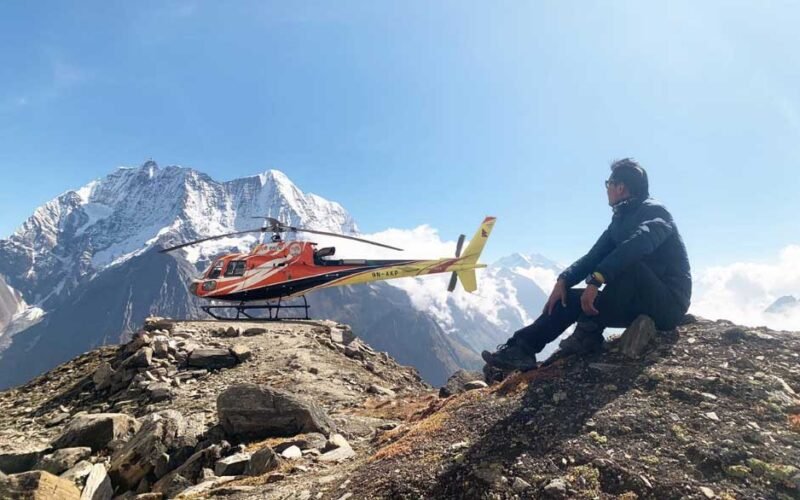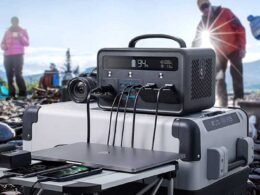Standing at the foot of the world’s tallest mountain is a dream for many, but the trek to Everest Base Camp isn’t easy—especially when time and energy are limited. That’s where the Everest Base Camp Trek with helicopter return offers a game-changing solution. This option allows you to experience the full magic of the legendary route to base camp and then skip the tiring descent with a scenic heli ride back to Lukla or Kathmandu.
Many trekkers don’t realize until midway through their journey just how demanding the return leg can be, especially after days of altitude gain and unpredictable mountain weather. This blog is here to help you make an informed decision before booking, so you avoid common pitfalls and get the most value from your adventure.
We’ll break down who this trek is best suited for, what costs and safety factors to consider, and why this increasingly popular option might be the perfect fit for your Everest dreams—without sacrificing comfort, time, or the thrill of the Himalayas.
Why Choose the Everest Base Camp Trek with Helicopter Return?
Save Time Without Cutting Corners
The trek to Everest Base Camp takes 8-10 days. Returning on foot can take another 3-4 days. For travelers with limited time, the helicopter return cuts the trip duration significantly.
By flying back, you free up days for sightseeing in Kathmandu or relaxing post-trek.
Avoid Physical Strain on the Return
After reaching base camp, fatigue kicks in. Your body has endured high altitudes, cold nights, and tough climbs.
Skipping the descent helps prevent injuries, especially on the steep downhill trails between Lobuche and Namche.
Even experienced Sherpas prefer air return after multiple trips. It reduces wear on joints and improves recovery time.
Enjoy a Bucket-List Heli Ride
The return flight offers unmatched views of Mt. Everest, Lhotse, and Ama Dablam.
Flying above the Khumbu Glacier and rugged terrain gives a fresh appreciation of what you just trekked.
Many trekkers say the heli ride was the highlight of their journey.
Safer in Unpredictable Weather
Weather in the Himalayas shifts quickly. Snow or wind can make trails unsafe, especially post-monsoon.
With a helicopter return, you can bypass weather delays and evacuate quickly if needed.
Trekking guides report that AMS (acute mountain sickness) symptoms often appear during descent. Helicopter return minimizes that risk.
Perfect for Specific Traveler Types
This option suits:
- Time-sensitive travelers
- Older or less physically active trekkers
- Luxury adventure seekers
- Photographers and filmmakers needing stable shots from the air
Choosing the Everest Base Camp trek with helicopter return isn’t just about convenience. It’s about maximizing your experience while minimizing stress, risk, and exhaustion.
That makes it a smart, experience-enhancing upgrade for the modern Himalayan adventurer.
Who Is This Trekking Option Best Suited For?
Not every traveler has the same goals, stamina, or schedule. The Everest Base Camp trek with helicopter return caters to several specific needs.
1. Time-Conscious Travelers
Many visitors to Nepal are on a tight itinerary. With the heli return, the trek is trimmed by 3-4 days.
That makes it ideal for professionals, families on holiday, or those combining multiple adventures in one trip.
2. Trekkers with Moderate Fitness
You don’t need to be an athlete to enjoy this trek. If you can handle 5-6 hours of hiking a day, you’re set.
Removing the return hike lowers the physical demand by nearly 30%.
Sherpa guides often recommend this to first-time trekkers or those above 50 who want to minimize strain.
3. Luxury and Comfort Seekers
This option is popular among travelers looking for a premium Himalayan experience.
Staying at high-end lodges and ending with a scenic flight appeals to those wanting adventure with added comfort.
4. Content Creators and Photographers
Photographers get a rare chance to capture Everest and its neighbors from above.
Drones are restricted in Sagarmatha National Park, so a helicopter offers unmatched aerial footage opportunities.
5. Trekkers Prone to Altitude Issues
Altitude sickness can hit unexpectedly—even on the way down.
Choosing a helicopter return offers an exit strategy that reduces risk and ensures peace of mind.
Bonus: Ideal for Second-Time Trekkers
Many who’ve completed the classic EBC trek return for a new experience.
This time, they skip the return hike and fly back—making it a fresh and more relaxed adventure.
Whether you’re short on time, seeking added safety, or craving comfort, this trek format delivers a Himalayan experience tailored to your needs.
What Is the Best Time to Book the Everest Base Camp Trek with Heli Return?
Choosing the right season is key to a successful Everest Base Camp trek with helicopter return.
Weather, visibility, and trail conditions can make or break your Himalayan adventure.
Best Seasons: Spring and Autumn
- Spring (March to May): Ideal weather, blooming rhododendrons, and clear skies make this the most popular time.
- Autumn (late September to November): Stable weather and panoramic views after the monsoon.
Both seasons offer excellent flying conditions and fewer delays for helicopter flights.
Sherpas often recommend autumn for crystal-clear views and more stable weather patterns.
Winter Trekking (December to February)
- Fewer crowds and a peaceful atmosphere.
- Freezing temperatures and possible snowfall make trails tougher.
- Heli flights may be delayed due to morning fog and wind.
If you enjoy solitude and colder climates, winter can work—but only with strong preparation.
Monsoon Season (June to Mid-September)
- Heavy rains and poor visibility make this the least favorable time.
- Landslides can affect lower sections of the trail.
- Helicopter flights are frequently canceled or delayed.
Only consider this season if you’re experienced and have flexible travel plans.
When to Book
- Book at least 3-6 months in advance for spring and autumn departures.
- Heli return slots fill quickly due to limited aircraft.
Booking early also ensures better lodge availability along the trail.
How Much Does It Cost to Trek Everest Base Camp with Helicopter Return?
The cost of an Everest Base Camp trek with helicopter return depends on several key factors: group size, services, and timing.
Average Price Range
- Standard package: USD 2,000 to 2,500 per person
- Luxury package: USD 3,000 to 4,500+ per person (includes better lodges and private flights)
Helicopter return adds USD 500 to 1,000 to the total price, depending on availability and flight route.
What’s Typically Included
- Domestic flights (Kathmandu–Lukla roundtrip)
- Licensed guide and porter
- Accommodation in tea houses or lodges
- Breakfast, lunch, and dinner during the trek
- Trekking permits (TIMS and Sagarmatha National Park entry)
- Helicopter return from Gorakshep or Pheriche
Additional Expenses to Budget For
- Travel insurance covering high-altitude evacuation (mandatory)
- Tips for guide and porter (USD 100–150 recommended)
- Gear rental or purchase
- Meals in Kathmandu
- Extra acclimatization days or sightseeing extensions
Cost Factors That Influence the Final Price
- Group Size: Larger groups can share helicopter costs, reducing individual rates.
- Season: Prices rise during spring and autumn peak months.
- Trek Duration: Adding acclimatization days or detours (e.g., Gokyo Lakes) increases costs.
- Flight Route: Helicopter drop-off at Lukla is cheaper than flying all the way to Kathmandu.
Real-World Insight from Trek Leaders
Guides suggest budgeting a buffer of USD 300–500 for emergencies or weather-related flight changes.
Some travelers end up needing extra nights in Lukla or Kathmandu due to delays.
Value vs. Cost
While the Everest Base Camp trek with heli return costs more than a standard trek, the experience often outweighs the price.
You get more comfort, safety, and unforgettable views—plus time saved for other adventures.
For many, it’s a once-in-a-lifetime journey worth investing in.
What to Pack for the Everest Base Camp Trek with Helicopter Return?
Packing smart is key to a comfortable and safe Everest Base Camp trek with helicopter return.
You need to balance essentials with weight restrictions on the helicopter.
Clothing Essentials
- Base layers: Moisture-wicking tops and thermal underwear
- Insulation: Down jacket and fleece layers for warmth
- Shell: Waterproof jacket and pants
- Trekking pants: Convertible or quick-dry
- Hat and gloves: Warm and windproof
- Buff or scarf: For sun and dust protection
Sherpas recommend layering to adapt to fluctuating temperatures at different altitudes.
Footwear and Socks
- Hiking boots: Waterproof with good ankle support
- Camp shoes: Lightweight for lodges
- Thermal socks: At least 3 pairs (plus 2 liner socks)
Break in your boots before the trek to avoid blisters.
Gear and Accessories
- Daypack: 25–35L with rain cover
- Duffel bag: Carried by porters (max 10–12 kg)
- Sleeping bag: Rated to -10°C or lower
- Trekking poles: Helpful on descents
- Headlamp: With spare batteries
- Water bottles: Or hydration bladder (2–3L total)
- Snacks: Energy bars, trail mix, and electrolytes
For heli return, soft-sided duffels are preferred due to limited cabin space.
Toiletries and Personal Items
- Sunscreen and lip balm: High SPF
- Wet wipes and hand sanitizer: Water is limited
- Toilet paper: Always carry your own
- Basic meds: Altitude tablets, pain relievers, band-aids
Documents and Electronics
- Passport and permits: Keep copies as backup
- Cash: Small notes for remote villages
- Phone and charger: Solar charger or power bank
- Camera: Compact or GoPro preferred for aerial views
Pro Tip from Guides
Pack essentials in your daypack, especially for the helicopter return.
Weather delays or rerouting may separate you temporarily from your main duffel.
Keeping gear light and organized ensures smooth trekking and a stress-free heli flight.
This packing list is optimized for the Everest Base Camp trek with heli return—comfort, safety, and practicality all in one.
Conclusion
Trekking to Everest Base Camp is no small feat, and choosing a helicopter return adds smart comfort to the adventure.
You save time, reduce physical strain, and experience the mountains from a whole new perspective.
From packing tips to seasonal advice and cost breakdowns, this guide gives you everything you need to plan with confidence.
If you’re dreaming of Everest but want to trek smarter, not harder, this option is worth every step—and flight.
Have questions or are you ready to book your EBC trek with heli return? Drop a comment or reach out to our team of experts.
We’d love to help you make your Himalayan journey unforgettable.










